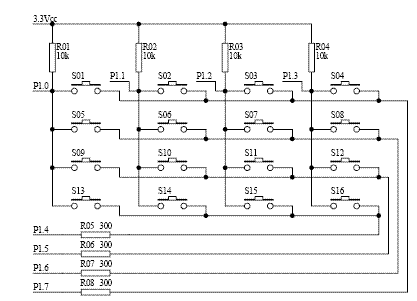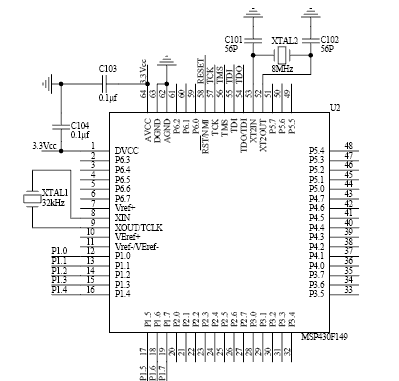MSP430 按鍵程序范例(附原理圖)
void Init_Port(void)
{
//將P1口所有的管腳在初始化的時(shí)候設(shè)置為輸入方式
P1DIR = 0;
//將P1口所有的管腳設(shè)置為一般I/O口
P1SEL = 0;
// 將P1.4 P1.5 P1.6 P1.7設(shè)置為輸出方向
P1DIR |= BIT4;
P1DIR |= BIT5;
P1DIR |= BIT6;
P1DIR |= BIT7;
//先輸出低電平
P1OUT = 0x00;
// 將中斷寄存器清零
P1IE = 0;
P1IES = 0;
P1IFG = 0;
//打開管腳的中斷功能
//對(duì)應(yīng)的管腳由高到低電平跳變使相應(yīng)的標(biāo)志置位
P1IE |= BIT0;
P1IES |= BIT0;
P1IE |= BIT1;
P1IES |= BIT1;
P1IE |= BIT2;
P1IES |= BIT2;
P1IE |= BIT3;
P1IES |= BIT3;
_EINT();//打開中斷
return;
}
void Delay(void)
{
int i;
for(i = 100;i--;i > 0) ;//延時(shí)一點(diǎn)時(shí)間
}
int KeyProcess(void)
{
int nP10,nP11,nP12,nP13;
int nRes = 0;
//P1.4輸出低電平
P1OUT &= ~(BIT4);
nP10 = P1IN & BIT0;
if (nP10 == 0) nRes = 13;
nP11 = P1IN & BIT1;
if (nP11 == 0) nRes = 14;
nP12 = P1IN & BIT2;
if (nP12 == 0) nRes = 15;
nP13 = P1IN & BIT3;
if (nP13 == 0) nRes = 16;
//P1.5輸出低電平
P1OUT &= ~(BIT4);
nP10 = P1IN & BIT0;
if (nP10 == 0) nRes = 9;
nP11 = P1IN & BIT1;
if (nP11 == 0) nRes = 10;
nP12 = P1IN & BIT2;
if (nP12 == 0) nRes = 11;
nP13 = P1IN & BIT3;
if (nP13 == 0) nRes = 12;
//P1.6輸出低電平
P1OUT &= ~(BIT4);
nP10 = P1IN & BIT0;
if (nP10 == 0) nRes = 5;
nP11 = P1IN & BIT1;
if (nP11 == 0) nRes = 6;
nP12 = P1IN & BIT2;
if (nP12 == 0) nRes = 7;
nP13 = P1IN & BIT3;
if (nP13 == 0) nRes = 8;
//P1.7輸出低電平
P1OUT &= ~(BIT4);
nP10 = P1IN & BIT0;
if (nP10 == 0) nRes = 1;
nP11 = P1IN & BIT1;
if (nP11 == 0) nRes = 2;
nP12 = P1IN & BIT2;
if (nP12 == 0) nRes = 3;
nP13 = P1IN & BIT3;
if (nP13 == 0) nRes = 4;
P1OUT = 0x00;//恢復(fù)以前值。
//讀取各個(gè)管腳的狀態(tài)
nP10 = P1IN & BIT0;
nP11 = P1IN & BIT1;
nP12 = P1IN & BIT2;
nP13 = P1IN & BIT3;
for(;;)
{
if(nP10 == 1 && nP11 == 1 && nP12 == 1 && nP13 == 1)
{
//等待松開按鍵
break;
}
}
return nRes;
}
// 處理來自端口 1 的中斷
interrupt [PORT1_VECTOR] void PORT_ISR(void)
{
Delay();
KeyProcess();
if(P1IFG & BIT0)
{
P1IFG &= ~(BIT0);// 清除中斷標(biāo)志位
}
if(P1IFG & BIT1)
{
P1IFG &= ~(BIT1);// 清除中斷標(biāo)志位
}
if(P1IFG & BIT2)
{
P1IFG &= ~(BIT2);// 清除中斷標(biāo)志位
}
if(P1IFG & BIT3)
{
P1IFG &= ~(BIT3);// 清除中斷標(biāo)志位
}
}
void Init_CLK(void)
{
unsigned int i;
BCSCTL1 = 0X00;//將寄存器的內(nèi)容清零
//XT2震蕩器開啟
//LFTX1工作在低頻模式
//ACLK的分頻因子為1
do
{
IFG1 &= ~OFIFG; // 清除OSCFault標(biāo)志
for (i = 0x20; i > 0; i--);
}
while ((IFG1 & OFIFG) == OFIFG); // 如果OSCFault =1
BCSCTL2 = 0X00;//將寄存器的內(nèi)容清零
BCSCTL2 += SELM1;//MCLK的時(shí)鐘源為TX2CLK,分頻因子為1
BCSCTL2 += SELS;//SMCLK的時(shí)鐘源為TX2CLK,分頻因子為1
}






評(píng)論